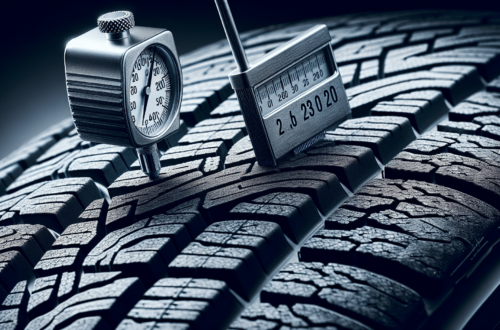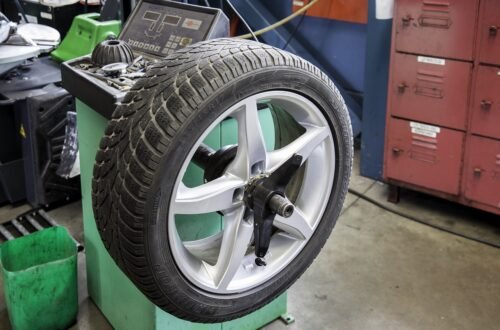With summer just around the corner, it’s time to hit the road and enjoy the warm weather. But before you take off on your next adventure, it’s essential to ensure your safety on the road, and that starts with your tires. In this article, we’ll provide you with some simple yet effective tips to maximize your safety this summer, keeping you and your loved ones protected while you embark on unforgettable journeys. So, put your mind at ease and get ready to make the most of the sunny days ahead with these summer tire safety tips.
Maximize Your Safety with These Summer Tire Tips
Choose the Right Summer Tires
Understand the Different Types of Summer Tires
When it comes to choosing summer tires, it’s essential to understand the different types available to you. The three main types of summer tires are performance tires, touring tires, and high-performance tires. Performance tires are designed for sports cars and provide excellent traction and handling. Touring tires, on the other hand, are ideal for sedans and offer a smooth and comfortable ride. Lastly, high-performance tires are perfect for luxury vehicles and deliver superior performance and cornering capabilities. Knowing the differences among these types will help you make the right choice for your specific driving needs.
Consider Your Climate and Driving Conditions
Your climate and driving conditions play a significant role in selecting the right summer tires. If you live in an area with hot and dry summers, a standard summer tire should suffice. However, if you frequently encounter heavy rain or wet roads, you might want to consider high-performance summer tires with enhanced wet traction capabilities. It’s crucial to assess your typical driving conditions and choose tires that can handle them safely and effectively.
Check the Speed Rating of the Tires
Before purchasing summer tires, it’s important to check their speed rating. The speed rating indicates the maximum speed capability of the tires and is represented by a letter code. The higher the letter in the alphabet, the higher the speed rating. It’s essential to choose tires with a speed rating that matches or exceeds the top speed of your vehicle. This ensures that your tires can safely handle the speeds you intend to drive.
Select the Correct Tire Size for Your Vehicle
Selecting the correct tire size for your vehicle is crucial for both performance and safety. Using the manufacturer’s recommended tire size ensures that the tires fit properly on your wheels, allowing for optimal handling, braking, and stability. To determine the correct tire size for your vehicle, refer to your vehicle’s owner’s manual or check the sidewall of your existing tires. Choosing the right tire size ensures a proper fit and contributes to a safe and comfortable driving experience.
Inspect and Maintain Your Tires
Check the Tread Depth Regularly
Regularly checking the tread depth of your summer tires is vital for maintaining traction and ensuring safe driving. The tread depth is the measurement between the top of the tread and the bottom of the tire’s deepest groove. Bald or worn-out tires with insufficient tread depth can compromise your vehicle’s ability to grip the road, especially in wet or slippery conditions. To check the tread depth, use a tread depth gauge or a simple penny. Insert the penny into the tread groove with Lincoln’s head facing downward. If you can see the top of Lincoln’s head, it’s time to replace your tires.
Look for Signs of Wear and Tear
In addition to monitoring tread depth, it’s essential to regularly inspect your summer tires for signs of wear and tear. Look for any cracks, bulges, or cuts on the tire’s sidewall or tread surface. These can be indicators of tire damage or potential blowouts. Additionally, pay attention to any vibrations, steering wheel wobbles, or uneven tire wear patterns, as these could suggest alignment or suspension issues. Catching and addressing these signs of wear and tear early can help prevent accidents and extend the lifespan of your tires.
Ensure Proper Tire Inflation
Proper tire inflation is key to maintaining optimal performance and safety. Underinflated tires can lead to increased rolling resistance, reduced fuel efficiency, and uneven tire wear, while overinflated tires can result in decreased traction and a harsher ride. To ensure proper inflation, refer to your vehicle’s owner’s manual for the recommended tire pressure. Regularly check the tire pressure with a tire pressure gauge and adjust as needed. It’s best to check tire pressure when the tires are cold, as heat generated from driving can influence pressure readings.
Rotate Your Tires for Even Wear
To ensure even wear on your summer tires, it’s important to have them rotated regularly. Tire rotation involves moving the tires from one position to another on your vehicle. This helps distribute the wear evenly across all four tires, prolonging their lifespan and improving overall performance. Refer to your vehicle’s owner’s manual for the recommended tire rotation schedule, as it may vary depending on the type of vehicle you drive. Regular tire rotation is a simple yet effective maintenance practice that can significantly impact the longevity and performance of your summer tires.

This image is property of images.unsplash.com.
Properly Store Winter Tires
Clean and Dry the Tires Before Storage
Properly storing your winter tires when summer arrives is crucial to maintain their quality and performance. Before storing your winter tires, make sure to clean and dry them thoroughly. Remove any dirt, debris, or brake dust from the tires using a mild soap and water solution. Dry the tires completely to prevent moisture from causing damage during storage. Clean and dry tires not only look better but also help prevent deterioration and extend their lifespan.
Avoid Storing Tires Near Heat or Direct Sunlight
When storing your winter tires, it’s important to choose a location away from heat sources or direct sunlight. Exposure to intense heat or UV rays can cause the rubber to deteriorate faster, leading to cracks and other structural damage. Ideally, store your tires in a cool and dry area, such as a garage or basement. If you must store them outside, use tire covers or bags to protect them from the sun’s harmful rays and keep them in the best possible condition.
Use Tire Covers or Bags to Protect from Dust and UV Rays
Using tire covers or bags is a great way to further protect your winter tires during storage. These covers or bags provide an extra layer of protection against dust, dirt, and UV rays. They help prevent the tires from dry rotting or developing cracks. When storing your winter tires, invest in quality tire covers or bags that are designed specifically for this purpose. This simple step can significantly prolong the life of your tires and ensure they are in excellent condition when the winter season arrives again.
Store Tires in a Cool and Dry Location
The temperature and humidity of the storage location can affect the longevity and performance of your winter tires. It’s best to store them in a cool and dry area to prevent moisture buildup, which can lead to mold or mildew growth. If possible, elevate the tires off the ground to avoid contact with concrete or other surfaces that can conduct heat and cause tire damage. Proper storage conditions will help maintain the integrity of your winter tires, ensuring they are ready to perform when winter rolls around again.
Know the Tire Maintenance Schedule
Follow the Manufacturer’s Recommended Maintenance Schedule
To maximize the lifespan and performance of your summer tires, it’s important to follow the manufacturer’s recommended maintenance schedule. Refer to the tire manufacturer’s guidelines for information on tire rotations, inspections, and replacements. Following these recommendations will help you stay on top of tire maintenance tasks and ensure that your tires are in optimal condition.
Regularly Check the Tire Pressure
Regularly checking the tire pressure is a crucial part of tire maintenance. Properly inflated tires not only improve fuel efficiency but also enhance handling and traction. Use a tire pressure gauge to check the pressure of each tire, including the spare, at least once a month. If the pressure is too low or too high, adjust it accordingly. Remember to check the tire pressure when the tires are cold for the most accurate reading.
Schedule Professional Inspections
While regular visual inspections are important, it’s also beneficial to schedule professional tire inspections. Tire experts can identify issues that may not be noticeable to the untrained eye, such as internal damage or hidden wear. Schedule regular inspections with a trusted mechanic or tire specialist to have your summer tires thoroughly examined and ensure that they are free of any hidden damage.
Replace Tires at the Recommended Mileage
Just like any other component of your vehicle, summer tires have a limited lifespan. It’s essential to replace your tires when they reach the recommended mileage. The exact mileage varies depending on the type and brand of tires, as well as driving conditions. Refer to the tire manufacturer’s recommendations for the ideal replacement mileage. By replacing your tires at the appropriate time, you can maintain optimal traction, handling, and overall safety on the road.

This image is property of images.unsplash.com.
Drive Safely on Wet Roads
Reduce Speed and Increase Following Distance
When driving on wet roads, it’s crucial to adjust your driving habits for the conditions. Reduce your speed to allow for increased stopping distance and better control of your vehicle. In wet conditions, it takes longer for your tires to grip the road, so maintaining a safe following distance is essential. Give yourself ample space to react to any sudden changes in traffic or road conditions.
Avoid Hard Braking and Acceleration
Hard braking and acceleration can significantly impact your tires’ ability to maintain traction on wet roads. When approaching a stop or starting from a stop, apply the brakes and accelerator gently to avoid causing your tires to lose grip. By avoiding abrupt stops and starts, you can minimize the risk of skidding or sliding on wet surfaces.
Gently Steer around Puddles and Standing Water
When encountering puddles or standing water on the road, it’s important to navigate them carefully. Driving through deep water can cause your tires to lose contact with the road, resulting in hydroplaning or aquaplaning. To avoid this, gently steer around puddles or standing water, if possible. If you cannot avoid them, slow down and drive through them at a controlled speed to maintain control of your vehicle.
Be Cautious of Hydroplaning
Hydroplaning occurs when a layer of water accumulates between the tires and the road, causing loss of traction and control. To prevent hydroplaning, it’s essential to drive at a moderate speed and avoid abrupt steering inputs or sudden braking. Additionally, make sure your tires have sufficient tread depth and are properly inflated. Good tires with adequate tread can effectively channel water away from the tire’s contact patch, reducing the risk of hydroplaning.
Be Prepared for Tire Emergencies
Carry a Spare Tire and Tools for Changing Tires
In case of a tire emergency, it’s important to be prepared. One essential item to have is a spare tire. A spare tire can provide a temporary solution if you encounter a flat or damaged tire while on the road. In addition to a spare tire, make sure you have the necessary tools for changing tires. These typically include a jack, lug wrench, and any special tools specific to your vehicle’s tire changing process. Familiarize yourself with the tire changing procedure outlined in your vehicle’s owner’s manual to ensure you can handle a tire emergency efficiently.
Know How to Change a Flat Tire
Knowing how to change a flat tire is a valuable skill that every driver should possess. In the event of a flat tire, being able to change it yourself can save time, money, and frustration. Familiarize yourself with the step-by-step process of changing a tire before you find yourself in a roadside emergency. Practice changing a tire in a safe, controlled environment, such as your driveway, to build confidence in your ability to handle a flat tire situation.
Have a Tire Inflator or Sealant for Temporary Repairs
In some cases, a flat tire can be temporarily repaired with a tire inflator or sealant. These products can help seal small punctures and reinflate the tire, allowing you to reach a nearby service station for a proper repair or replacement. It’s important to note that tire inflators and sealants are temporary solutions and should not be considered a permanent fix. Have a tire inflator or sealant on hand in case of emergencies, but remember to get your tire repaired or replaced as soon as possible for long-term safety.
Consider Joining a Roadside Assistance Program
If you frequently drive long distances or find yourself in unfamiliar areas, joining a roadside assistance program can provide peace of mind in the event of a tire emergency. Roadside assistance programs offer services such as tire changes, jump-starts, and towing, ensuring you have professional help when you need it most. Research different roadside assistance programs and choose one that fits your needs and budget. Having access to reliable assistance can make a significant difference in stressful and potentially dangerous situations on the road.

This image is property of images.unsplash.com.
Avoid Overloading Your Vehicle
Check the Load Capacity of Your Tires
Every tire has a specific load capacity, indicating the maximum weight it can safely carry. It’s essential to check the load capacity of your tires and ensure that it is not exceeded. Overloading your vehicle can lead to excessive strain on the tires, resulting in premature wear, decreased handling, and increased risk of a tire failure. Refer to the tire manufacturer’s specifications or consult a tire expert to determine the load capacity of your tires.
Distribute the Load Evenly in Your Vehicle
Properly distributing the load in your vehicle is important to maintain optimum tire performance and safety. Uneven weight distribution can cause excessive strain on certain tires, leading to uneven wear and decreased handling. When loading your vehicle, distribute the weight as evenly as possible. Make sure heavy items are secured properly and do not exceed the load capacity of your tires or vehicle.
Avoid Exceeding the Vehicle’s Gross Axle Weight Rating
The Gross Axle Weight Rating (GAWR) is the maximum weight that each axle of your vehicle can safely carry. It’s crucial to avoid exceeding the GAWR to prevent excessive strain on the tires and other components of your vehicle’s suspension system. The GAWR can typically be found on a sticker inside your vehicle’s driver-side door frame or in the owner’s manual. By adhering to the GAWR, you can ensure that your tires are not subjected to unnecessary stress, maintaining optimal performance and safety.
Remove Unnecessary Weight to Reduce Strain on Tires
Carrying unnecessary weight in your vehicle can put unnecessary strain on your tires. From sports equipment to tools, it’s important to regularly evaluate what is essential to have in your car and remove any unnecessary items. The lighter the load, the less strain your tires will experience during acceleration, braking, and cornering. By reducing the weight in your vehicle, you can help prolong the life of your tires and enjoy improved fuel efficiency.
Check the Wheel Alignment
Schedule Regular Wheel Alignments
Regular wheel alignments are essential for optimal tire performance and handling. Over time, the wheels of your vehicle can become misaligned due to factors such as potholes, curb impacts, or normal wear and tear. Regularly scheduling wheel alignments, typically once a year or as recommended by your vehicle’s manufacturer, ensures that your tires wear evenly and your vehicle’s steering and suspension systems are working properly.
Look for Signs of Misalignment
Keeping an eye out for signs of misalignment is important in maintaining tire health and safety. Some common signs of misalignment include uneven tire wear, vehicle pulling to one side, vibrating or shaking steering wheel, and a crooked steering wheel when driving straight. If you notice any of these signs, it’s crucial to have your vehicle’s wheel alignment checked as soon as possible. Ignoring misalignment can lead to increased tire wear, reduced fuel efficiency, and compromised handling.
Adjust Front and Rear Wheel Alignment
Both the front and rear wheels of your vehicle play a role in maintaining optimal tire performance. Front wheel alignment refers to the angles of the front tires, while rear wheel alignment focuses on the angles of the rear tires. Both alignments need to be adjusted correctly to ensure even tire wear and proper handling. During a wheel alignment service, a technician will assess and adjust the angles of all four wheels, ensuring that they meet the manufacturer’s specifications.
Ensure Proper Tire Wear and Handling
Proper wheel alignment directly impacts tire wear and handling. When your wheels are properly aligned, your tires wear evenly, prolonging their lifespan. Additionally, proper alignment improves vehicle handling, ensuring that your tires maintain optimal contact with the road surface. By prioritizing wheel alignment, you can ensure that your tires perform at their best, providing you with a safe and comfortable driving experience.
Be Mindful of Tire Age
Inspect the Tire Sidewalls for Signs of Aging
Tire age is an important factor to consider when it comes to tire safety. Over time, the rubber compounds in tires can degrade, leading to decreased performance and an increased risk of failure. Inspect the sidewalls of your summer tires for signs of aging, such as cracking, bulging, or dry rot. These signs indicate that the tire’s structural integrity may be compromised. If you notice any of these signs, it’s crucial to have your tires inspected by a professional and consider replacing them if necessary.
Check the Date Code to Determine Tire Age
To determine the age of your tires, check the date code imprinted on the sidewall. The date code consists of four digits, with the first two indicating the week and the last two indicating the year of manufacture. For example, a tire with a date code of 2619 was manufactured in the 26th week of 2019. Tires have a maximum lifespan of six to ten years, depending on various factors. If your tires are approaching the six-year mark, it may be time to consider replacement.
Consider Replacing Tires Older than Six Years
As tires age, their rubber compounds deteriorate, leading to decreased performance and increased risk of failure. While the exact lifespan of a tire depends on several factors, including usage and storage conditions, it’s generally recommended to replace tires that are older than six years, regardless of their tread depth. Even if your tires appear to be in good condition, the underlying rubber may have become brittle, compromising your safety on the road. Prioritize safety by replacing aging tires and ensure peace of mind during your summer travels.
Store Tires Properly to Extend Their Lifespan
Proper storage is crucial in extending the lifespan of your tires. When not in use, store your summer tires in a cool and dry location, away from direct sunlight and heat sources. Make sure the tires are clean and dry before storage to prevent moisture or debris from causing damage. If possible, elevate the tires off the ground to avoid contact with cold or damp surfaces. By storing your tires properly, you can prevent premature aging and maintain their performance for longer.
Seek Professional Help
Consult with a Tire Expert for Recommendations
When in doubt about any aspect of summer tire safety, it’s always a good idea to consult with a tire expert. Tire professionals have the knowledge and expertise to provide guidance and recommendations tailored to your specific needs and driving habits. Whether you have questions about tire types, maintenance practices, or safety concerns, a tire expert can offer valuable insights and help you make informed decisions to maximize your safety on the road.
Visit a Mechanic for Tire Inspections and Maintenance
Regular visits to a trusted mechanic for tire inspections and maintenance are crucial in ensuring your summer tires are in optimal condition. Mechanic inspections can identify potential issues that may go unnoticed during visual inspections, such as worn suspension components or alignment problems. A professional mechanic can also perform tasks like tire rotations, wheel alignments, and tire replacements with precision and accuracy, ensuring the best possible performance and safety.
Get Professional Assistance for Tire Replacements and Repairs
Tire replacements and repairs should be handled by professionals to ensure your safety on the road. While it may be tempting to attempt DIY tire repairs or replacements, the expertise and equipment of a tire professional are crucial in correctly mounting and balancing tires. Additionally, professional assistance guarantees that your tires are properly inflated and aligned, maximizing performance and longevity. Invest in professional assistance for tire replacements and repairs to have the peace of mind that comes with expertly performed services.
Ask for Advice on Optimal Tire Safety Practices
When it comes to tire safety practices, it’s always beneficial to ask for advice from professionals. Tire experts and mechanics can provide valuable tips and recommendations to help you optimize the safety and performance of your summer tires. From tire pressure maintenance to choosing the right tires for your vehicle, seeking advice from knowledgeable professionals ensures that you are well-informed and equipped to make the best decisions for your safety on the road.
In conclusion, maximizing your safety with summer tires requires careful consideration and proper maintenance. Understanding the different types of summer tires, considering the climate and driving conditions, and checking the speed rating and tire size are crucial for making the right tire choice. Regularly inspecting and maintaining your tires, properly storing winter tires, following the tire maintenance schedule, driving safely on wet roads, being prepared for tire emergencies, avoiding overloading your vehicle, checking the wheel alignment, being mindful of tire age, and seeking professional help are essential practices for ensuring optimal safety and performance. By following these tips and making tire safety a priority, you can enjoy a safe and enjoyable summer driving experience.





